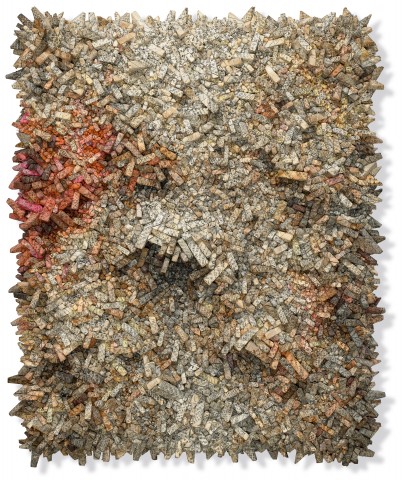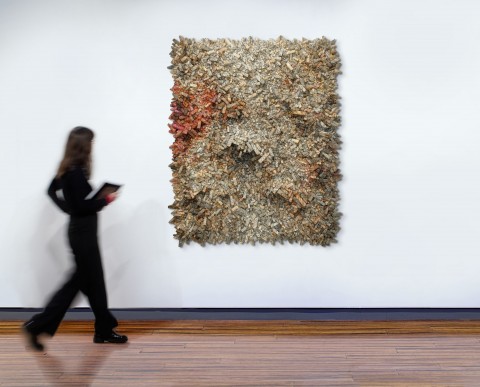AGGREGATION, 03-S142, 2003
CHUN KWANG YOUNG
Korean mulberry paper (hanji), styrofoam and string on board
175.0 x 145.0 cm
signed and inscribed verso: CHUN KWANG-YOUNG / AGGREGATION 03-S142 / 175 X 145 CM / MIXED MEDIA WITH KOREAN MULBERRY PAPER / -03 KYCHUN
bears inscription on gallery label verso: CHUN KWANG-YOUNG / Korea / Aggregation 03-S142, 2003 / Mulberry paper on board / 175 x 145 cm
Conny Dietzschold Gallery, Sydney (label attached verso)
Private collection, Sydney, acquired from the above in 2003
Chun, Kwang – Young, Aggregation, Newcontemporaries gallery, Sydney, 17 October – 30 November 2003
Revered as one of Korea’s foremost contemporary artists, Chun, Kwang-Young built his reputation in the United States upon a single fertile idea which has sustained over thirty years of continued practice – a unique means of conveying universal ideas about the human condition through a poetic and abstract form, using materials derived from his personal cultural heritage.
Chun’s sculptural reliefs are constructed with thousands of triangular prisms, building blocks each wrapped in printed Korean mulberry paper (Hanji) and held together with paper string, arranged into vast and complex configurations. A soft and durable natural material, this paper was ubiquitous in everyday life in pre-modern Korea, indispensable for the printing of academic and artistic texts, and was even used, when laminated with rice starch, for food preservation and as an architectural building material. Working on both a macro and micro scale, these prisms became the atoms that form Chun’s sculptural and topographical reliefs, each finished work titled Aggregation and numbered sequentially. By highlighting the subtle differences between relative size, tone and density and spatial orientation of the blocks, Chun creates effects of light, texture and even movement.
For Chun, each unique carved and wrapped prism is representative of a unit of information that, when collated (or aggregated) en masse, can be used as a metaphor for human collaboration and conflict. When viewed holistically, the prisms move as one in vast tides against one another and in opposition to the outside world. Chun spent many years in America training as an Abstract Expressionist painter and used this understanding of gesture and dynamic composition to create works which bristled with energy, at times even exploding out of the confines of their planar supports.
When viewed from a distance, the commanding presence of Chun Kwang-Young’s large wall hung sculpture Aggregation 03-S142, 2000 is undeniable. With a jagged texture, the physical limits of his unique paper medium extend far beyond the traditional rectangular picture plane, in abstract and poetically expressive formations. The individually dyed prisms jut forth and recede en masse, creating an impression of topographical waves converging into pitted and salient sections of light and dark. Beyond Chun’s dextrous manipulation of three-dimensional forms, the tonal contrast of natural red dyes across the picture’s surface is heightened by an arrangement of the relative density of printed text on each wrapping. Attracting close attention from the viewer, it is this textural detail that reveals the threads of cultural nostalgia and identity politics that form the foundations of Chun’s works.
For Chun, the significance of Hanji paper within his artwork was threefold: it heralded a return to traditional artisanal methods of creation, it linked his art to his own personal cultural heritage, and nostalgically connected his artworks to the wealth of human experience that had preceded him. The Hanji paper used in Chun’s Aggregations is second-hand, torn from the pages of old Korean and Chinese publications hoarded by the artist. It has become, for the artist, an extension of the lives of the hundreds of people who have come into contact with these sheets: ’For me, old paper has a life, a history... In a way, I’m wrapping the stories of people’s lives.’1
1. The artist, cited in Kloesnikov-Jessop, S., ‘Korean Artist Turns Old Mulberry Paper Into Modern Art’, The New York Times, New York, 14 August 2006, accessed online 16 March 2018 (http://www.nytimes.com/2006/08/14/arts/design/14chun.html)
LUCIE REEVES-SMITH

